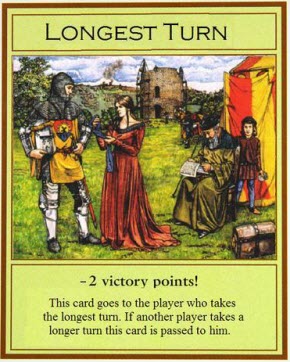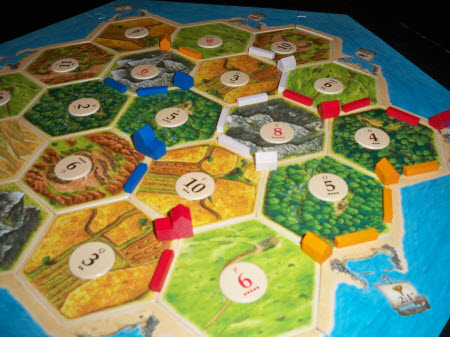The Neoclassics: Settlers of Catan
It occurred to us here at the Cardboard Republic that for all of our conversations on the matter, we haven’t touched upon the original Settlers of Catan. In part, it was because we didn’t feel the need, as it’s come to be regarded as the Gateway Game, the one that introduces the most new players to the analog gaming world. Combined with its exploding popularity here in the United States, it was thought unlikely we had anything new to bring to the table. Settlers is not suffering from underexposure, and countless board game authorities, YouTube talking heads, and casual gamers have already preached the Gospel of Catan the length and breadth of the Western World.
But it just doesn’t feel right to say nothing about the game that reignited widespread interest in the hobby.
We’ve decided to take a different tack. There are a number of games out there that are far newer than the “Classics” of the genre (Chess, Monopoly, Risk, Scrabble…) that have, in a manner of speaking, become the new staples. Settlers is one of course, but this also includes others such as Ticket to Ride, Carcassonne, and Puerto Rico. These are the “Neo-Classics”, those well-received and easily teachable games that board gamers have gravitated towards since they came out. We may not play them as much as our collections grow, but just as no family game shelf twenty or thirty years ago was complete without Scrabble, these are the games that we consider a necessary occupant on our shelf, especially where newcomers are concerned.
We would give these regular reviews, but not only are most people already familiar with them, they are already commercial successes. Instead, we’ll look at why they’ve done so well. What mechanics drew us in, what part of the design appealed to us? Do they still hold up today, or were they too more products of their time that have been outgrown?
The Inception
Settlers of Catan was released in 1995 by a German dental tech named Klaus Teuber. Teuber designed games for his family to play, and had already achieved some success in 1988 with a game called Barbarossa and the Riddlemaster. Designed originally as an exploration game, Settlers went through years of revision before he brought it to Germany’s Essen Fair. It was an instant success, selling so many copies that not even Teuber owns a first edition. It went on to make record sales throughout Germany, then Europe. It took a few years to enter the U.S. market, with Americans seemingly having moved on to video games over conventional board games as the go-to social gaming style. But once it hit, Settlers gained an instant following, and it is still climbing today.
The Rules
 The island of Catan is set up by laying out colored hexagon tiles in a random order, with each tile getting a numbered marker between two and twelve. Each player places two Settlements on the map, each on a corner of a hex, with a road along one of the adjacent sides. These initial Settlements do not need to be connected or near each other, but they will form the basis for player growth throughout the game.
The island of Catan is set up by laying out colored hexagon tiles in a random order, with each tile getting a numbered marker between two and twelve. Each player places two Settlements on the map, each on a corner of a hex, with a road along one of the adjacent sides. These initial Settlements do not need to be connected or near each other, but they will form the basis for player growth throughout the game.
At the beginning of each player’s turn, that player rolls two six-sided dice. If any player has a settlement on a hex with that number, they draw one resource of the type that terrain produces. If they have two settlements on that hex, they draw two.
There are six different terrains present on the island: Plains, which produce Grain; Pastures, which produce Sheep; Hills, which produce Clay/Brick; Mountains, which produce Ore; Forests, which produce Wood; and a Desert, which produces nothing but a Robber.
The objective is to be the first player to reach 10 Victory Points. Players use collected resources to build roads along the sides of the hexes, building new Settlements on the hex corners (worth 1 VP each), upgrading Settlements to Cities (worth 2 VP), and optionally buying Development Cards, which provide various special actions and added points. A road must be built connected to another of your roads, and Settlements must be connected to one of your roads, with at least two segments between it and any other Settlement.
Robbers & Barons
 It quickly becomes clear that most of the time players will not have access to every resource they need in the game, and that’s when the game’s trading system steps in. Players may trade resources to the bank at a 4:1 ratio, or slightly lower if they’re lucky and have a settlement in a special harbor.
It quickly becomes clear that most of the time players will not have access to every resource they need in the game, and that’s when the game’s trading system steps in. Players may trade resources to the bank at a 4:1 ratio, or slightly lower if they’re lucky and have a settlement in a special harbor.
Loading up on extra cards to turn in is risky, however, because whenever someone rolls a seven (statistically the most likely number to roll using two regular dice) any player with more than seven cards in their hand discards half of them. They also get to move the Robber to any hex on the board. That hex no longer produces goods for as long as the robber is there, and the one who moved him steals a resource from the player with a settlement on that hex.
 So if exchanging with the bank is expensive and risky, how does Catan encourage players to attain the resources they need?
So if exchanging with the bank is expensive and risky, how does Catan encourage players to attain the resources they need?
Why, the other players.
Yep, your opponents. On their turn, players may trade cards amongst themselves at any rate they choose. While no one is ever forced to make a trade, people often do for mutual benefit. This also brings an element of control to a game highly influenced by luck: If one player has grabbed a huge lead, the others working together can restrict his trading options and possibly allow the rest to catch up. What’s more, this brings player interaction to the forefront.
Gaming Year 18 A.C. (After Catan)
Catan seemed to revolutionize the gaming industry when it was released, proving to the general public that board games weren’t just for kids or hyper intellectual strategy buffs anymore. Almost twenty years later, the game is still going strong with numerous expansions, spinoffs, and rip-offs (Settlers of Canaan, anyone?). Few games can appeal to everyone all the time, but Settlers seems to have hit that sweet spot of pleasing more people than not. There are detractors of course – some players won’t like the high luck aspects (looking at you Strikers), some want more emphasis on strategy and skill (and you Tacticians), and others just seems to be contrary and refuse to like it just because it is popular.
So, what are the features of Catan that set it apart from others games of its day, apart from forcing people to realize that the games they grew up playing were not very well designed?
- Replayability: The overall island shape stays the same, but the terrain tile layout – and thus the strategies – will change every time. The luck of the dice also determines how many resources you rake in over the course of a game, forcing you to adjust your strategy accordingly. Will Wood be readily available this time around, or is it going to be a struggle to build roads? Every time you play Settlers of Catan, it will behave differently, and yet the game remains very easy to learn and understand. For people used to classics like Monopoly, an ever-changing game can be a real eye opener.
- “Friendly” Play: In Risk, your goal is to achieve Global Domination by assaulting your enemies’ forces and forcibly taking territory from them. In Monopoly, you win by slowly (so very slowly) bleeding your opponents’ coffers dry. In Settlers of Catan, you cannot attack their workers to halt production or lay siege to their settlements. Instead you are racing to achieve the most, the fastest. This isn’t to even remotely claim that you can’t interfere with other players, however. You may build roads to cut an opponent off from reaching a part of the map; it’s even possible to fence someone in and prevent them from expanding. Also, moving the Robber is often very confrontational that provokes retaliation. Still, while you can employ aggressive strategies, the game still shies away from direct conflict. At most, you can annoy the opposition by slowing them down, but by doing so you might end up hurting yourself in the long run.
- Strategy: This isn’t a Roll And Move game like Monopoly or Sorry!, where much of the game is out of your hands. Strategy is an important component to winning, particularly your opening Settlements. Catan is a balance of playing the odds and diversifying. Yes, six and eight have greater statistical chances of being rolled than three or ten, but if you control a port that allows you to trade Ore at a discounted rate, it might be better to build heavily on a Mountain with a ten than a Hill with a six. Savvy players will strike a balance between spreading out Settlements, obstructing opponents’ access to resources, and playing well-timed Development Cards. But it must be done carefully.
- Luck: Ever the great equalizer of board games, luck allows beginners and veterans to play together. Luck-based mechanics serve to bridge that gap in skill levels. Have you ever played Chess against someone who had more experience than you? How often will you want to play Chess against them again? Unless a game has a built-in handicap system, more knowledgeable players will tend to dominate play. In Settlers, resources are the lifeblood of the game. Tying resource production to the roll of a die keeps experienced players in check, allowing the roll of a die to let a weaker player to gain a strong position. Unfortunately, luck is also one of those great dividing points in the community. Many players hate it, seeing it as Settlers’ biggest weakness. Without it though, Catan would lack the low barrier to entry that makes it such an effective Gateway Game.
- Lack of Inactivity: Many turn-based games consist of doing what you can on your turn, then zoning out until it comes around to you again. It’s easy to get bored during these sometimes interminable waits. With Settlers, players stay involved no matter whose turn it is. When a player rolls the dice, everyone collects resources, so everyone has a stake in the die roll. Rather than sitting back and idly listening to what someone else might be collecting, you find yourself asking the other player to please finally roll a ten, because no one else has all game. You are emotionally and mentally engaged, the options in your hand changes every turn. With the wheeling and dealing of the trading system, most players stay connected in a semi-cooperative competition, emotional blackmail notwithstanding. It’s engaging and generally short, making it the type of game Socializers will appreciate.
The Legacy
 There have been many, many games that have come out since Settlers of Catan, and it’s no surprise that quite a few have improved upon ideas that Catan offers. One of these games is Settlers of Catan itself. It has a flexible enough design that the creator has been able to release expansion after expansion tailored to meet specific customer demands.
There have been many, many games that have come out since Settlers of Catan, and it’s no surprise that quite a few have improved upon ideas that Catan offers. One of these games is Settlers of Catan itself. It has a flexible enough design that the creator has been able to release expansion after expansion tailored to meet specific customer demands.
Want to try a different shaped island? Want to play a Catan game modeled after Ancient Greece or Egypt? Want to try your hand at exploration or interstellar commerce? (Yes, you read that correctly.) The game comes in enough flavors to satisfy whatever little tweak you think the game needs, and plenty of fan-made modifications if you can’t find what you’re looking for in the official library.
Settlers of Catan is not the end-all, be-all of board games, nor was it ever meant to be, but as a means to enlighten new players to a world beyond the classics, it’s achieved what it was meant to for almost twenty years and shows no signs of slowing yet. It remains a great recommendation for beginning players. It’s fast, simple, engaging, and everyone can play it. It is especially useful as a guidepost, allowing you to use a player’s response as a divining rod to point out what games to go to next for them.
Settlers of Catan is already a classic, and growing more so every year. Who knows? With luck, and enough name recognition, maybe it will finally replace the endless sea of Monopoly clones that comes to people’s minds when they hear the term “board game”…
[sc:reviewbar ]
Photo Credits: Settlers Closeup by Matt Walsh; Ports and Robber Signs by tristancannonsherlock; Longest Turn by Vanessa Leite.

